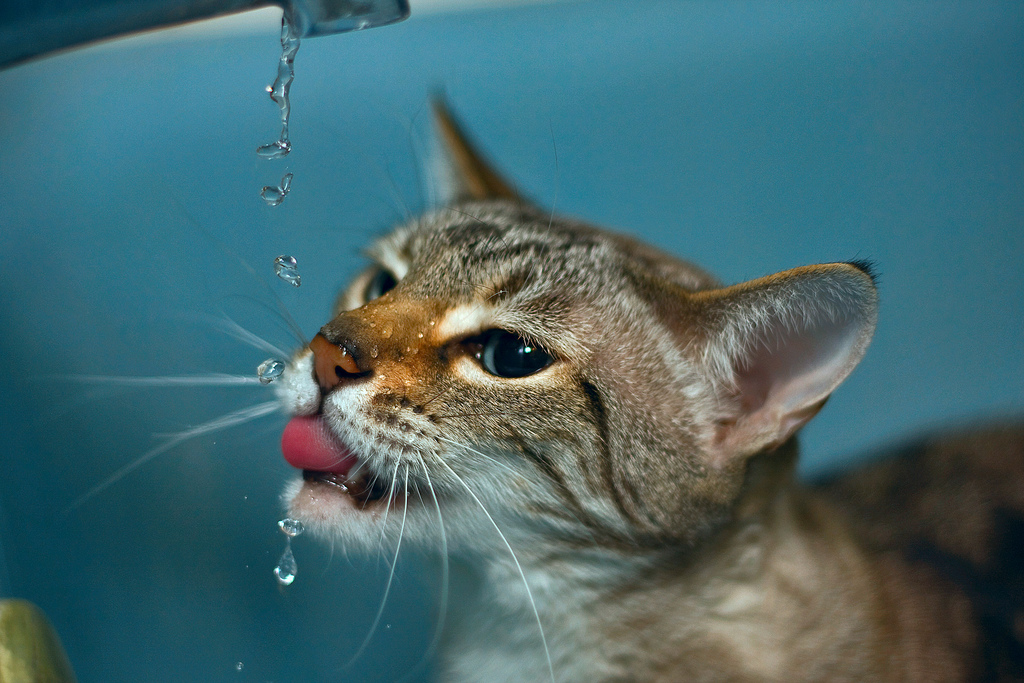FROM THE WILD DESERT TO YOUR COUCH: CATS HAVE RETAINED THE ABILITY TO CONSERVE WATER
Have you ever wondered about the reasons behind low water intake in cats? Reasons date back centuries. That little fur-ball purring contentedly on your couch originates to some of the first carnivores to evolve 35 million years ago. The African wild cat (Felis Sylvestris Lybica) is generally accepted as the ancestor of most of today’s domestic cats.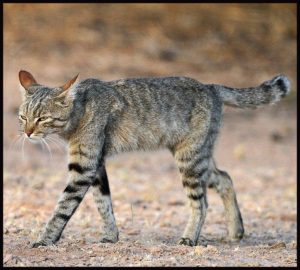
The Felis Sylvestris Lybica is the ancestor of most modern cats
BACKGROUND
Felis Sylvestris Lybica lived in Northern Africa, the Near East and around the periphery of the Arabian Peninsula. Their descendants still roam the deserts of Israel, Saudi Arabia and other countries in the Middle East today. Living in a desert environment where water sources are scarce, their body physiology adapted to the demands of their environment. This allowed low water intake in cats in these regions enabling them to survive. They have developed kidneys that are very efficient in conserving water and they are able to obtain most of the water they need from the food that they eat. They did not need a lot of water to survive. African wild cats are hunters with their main prey being rodents. Their natural diet also consisted of hares, rabbits, insects, birds, fish, and occasionally poultry and small livestock. The fresh meat of these animals is made of around 75% water and this is where wild cats get most of their water requirement from.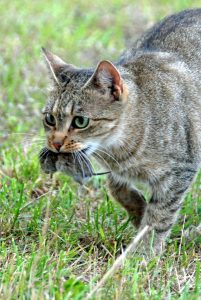
Wildcats and feral cats get most of their daily water requirement from the prey that they catch and eat.
COMMERCIAL CAT FOOD: WET VERSUS DRY
These characteristics inherited by our cats should pose no problem at all if they were allowed to go out and hunt for their natural food. But majority of cats being kept as pets today live purely indoors for safety reasons and are being fed with commercial food. In recent years, the growth of the pet food industry has skyrocketed and we have seen a deluge of commercial cat food, both wet canned and dry, in the market. Wet canned food is approximately 78% water and is closer in approximating fresh meat in terms of amounts of protein and water content. Dry food is at most only 10% water while having more carbohydrates than protein.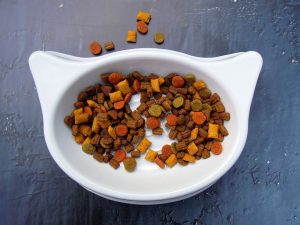
Modern dry cat food has at most 10% water
Perks of Dry food
Dry cat food has been called “unnatural” due to its very low water content, yet it is widely popular among pet owners because of its inherent advantages: (1) it can be kept longer after opened as long as it is placed in airtight containers, (2) it is easy and not messy to feed, (3) there is minimal waste, (4) it can be left longer in the bowl so the cat can have access to food even when the owner is away during the day, an advantage for busy cat parents, and (5) it is cheaper than canned wet food for pet parents on a tight budget.How to Maintain a Healthy Dry Food Diet
Many believe that dry food of superior quality, grain-free and having a specific meat in the ingredient, not just animal by-products, is not really bad for cats but they would need to drink more water to make up for the very low water content of these dry food. Therefore cats on dry food should have access to fresh water at all times and drink a sufficient amount of it. But even cats who are on a canned wet food diet need and greatly benefit from drinking extra water.THE DIFFICULTY OF GETTING CATS TO DRINK WATER
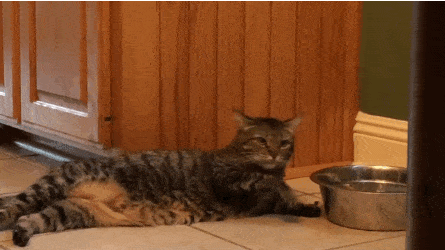 Water makes up about 80% of a cat’s body. It is essential for good health and vital to almost all body processes that maintain life. Cats need to drink more water, especially those who are on a dry food diet. Just keep kitty’s water bowl filled with water at all times and he will drink from it. Sounds fairly simple, right? But in reality pet parents know that seriously low water intake in cats can lead to complications.
As mentioned earlier, our domestic cats today have inherited the low thirst drive of their desert-dwelling ancestors so they are by nature not inclined to drink much water even when it is available. A compounding factor is the cat’s instinctive dislike for stagnant water making a still water bowl not good enough to provide for their daily water requirement.
Water makes up about 80% of a cat’s body. It is essential for good health and vital to almost all body processes that maintain life. Cats need to drink more water, especially those who are on a dry food diet. Just keep kitty’s water bowl filled with water at all times and he will drink from it. Sounds fairly simple, right? But in reality pet parents know that seriously low water intake in cats can lead to complications.
As mentioned earlier, our domestic cats today have inherited the low thirst drive of their desert-dwelling ancestors so they are by nature not inclined to drink much water even when it is available. A compounding factor is the cat’s instinctive dislike for stagnant water making a still water bowl not good enough to provide for their daily water requirement.
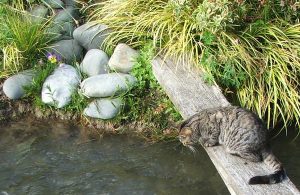
Cats instinctively know that running water is cooler, fresher and cleaner. Their good peripheral vision also allows them to see running water better.
PROBLEMS THAT ARISE WITH LOW WATER INTAKE IN CATS
When your cat does not care for the water in his bowl, it is difficult to force it to drink from it. This will result to your cat having long-term low-level dehydration especially when he is on dry food. Dehydration, a condition wherein there is a harmful reduction in the amount of water in the body, increases the risk for developing a host of problems primarily related to the urinary system and affecting other body systems as well.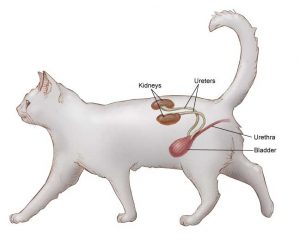
Simplified diagram of a cat’s urinary system. Water flowing through this system is essential for keeping it healthy.
Urine Becomes More Concentrated
When the body senses that the amount of water in the bloodstream is lacking, it compensates for this by reabsorbing water from the urine resulting to a urine that has increased specific gravity. This means that because water was reabsorbed, the urine becomes more concentrated. The risk for the formation and growth of urinary crystals and stones increases with concentrated urine.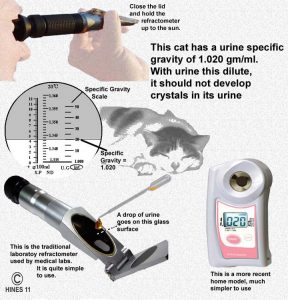
The measurement of urine specific gravity. It will tell how dilute or concentrated the cat’s urine is. Crystals are less likely to form in dilute urine of adequately hydrated cats.
Elevation of the BUN and Kidney Damage
BUN stands for Blood Urea Nitrogen. Urea is a chemical waste product from the breakdown of protein in the body. Normally bloodstream carries urea to the kidneys. The kidney filters the urea and other waste products from the blood and the waste leaves the body through the urine. A dehydrated cat’s blood volume will decrease and the blood will become thicker, resulting in slower blood flow from it’s organs back to the heart. When this happens, the heart reduces the amount of blood it can pump per minute and this affects the efficiency of the heart in sending blood to the other organs of the body. This reduces blood flow to the kidneys decreasing the effectiveness of blood filtration. The result is an increase in the amount of urea waste products remaining in the blood, hence elevation of the BUN.
Blood Urea Nitrogen (BUN) are toxic waste products in the blood. When a cat is not drinking enough water the toxins stay in the blood and can damage organs.
Increased Risk of Formation and Growth of Urinary Crystals and Stones
Dr. Richard Goldstein, a veterinarian at the Animal Medical Center in New York, USA observed that crystal and stone formation tends to occur in domesticated cats who don’t take enough fluids and don’t urinate enough. Urine is made up of water with suspended minerals, cells, proteins and other debris. Chronically dehydrated cats produce urine with higher concentrates of struvites or calcium oxalate. When they reach concentration threshold, the minerals precipitate out as microscopic crystals. Later these crystals combine to form sand like material which may accumulate more minerals forming urinary stones.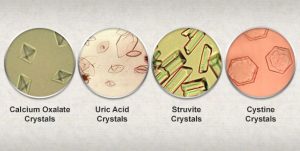
Examples of crystals that may form in the urine of a dehydrated cat. They may block the urethra and cause painful urination.
Proof of the Theory
A study in the Veterinary Clinics of North America: Small Animal Practice demonstrated interesting results. Their examination of obstructed cats found that 60.4% presented with urethral plug made of crystals, proteins and other debris in the urine, and 11.3% with uroliths. Also, a study showed the prevalence of urolithiasis has undergone considerable change over the last 20 years. The 2016 World Small Animal Veterinary Association Congress associated this change with the use of commercial dry diets.Negative Effects of Urinary Crystals and Stones
Urinary crystals are sand-like and they irritate the bladder causing inflammation. They may plug the urethra causing an obstruction to the flow of urine. This condition presents a bigger problem in male cats whose urethra are narrower than the female’s.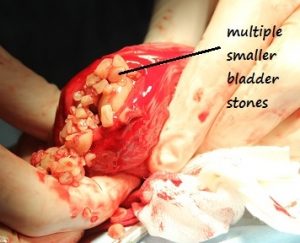
Urinary stones inside the bladder. They cause bladder irritation and block the flow of urine which may lead to kidney damage.
Feline Lower Urinary Tract Disease (FLUTD) and Cystitis
FLUTD is a term which groups disorders affecting the lower urinary tract (bladder or urethra) in cats. These disorders arise due to various predisposing factors. According to claims data published by the Veterinary Cat Insurance Company in Veterinary Economics, FLUTD is the most common reason owners took their cat to the veterinary office. In the article “Epidemiologic Study of the Risk Factors for Lower Urinary Tract Disease in Cats” published in the Journal of the American Veterinary Medical Association, uroliths account for 15-23% of FLUTD cases and bacterial urinary tract infections up to 22%. Other factors include stress, decreased moisture content of food and not consuming enough water to flush out/clean the bladder
Diagram of the posture a cat assumes during normal urination compared to difficult or painful urination.
Other Problems Caused By Chronic Low Water Intake in Cats and Dehydration
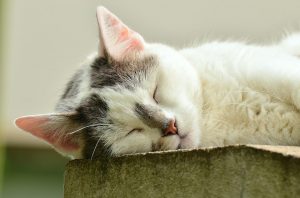
Low water intake in cats can lead to several health issues for cats and exhaustion

